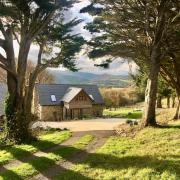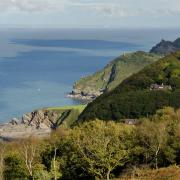Devon has many scenic secrets, but just east of Brixham there’s a headland that promises a spectacular summer day out. SOPHIE PAVELLE recounts a recent visit to Berry Head, wondering why it’s taken her so long to visit this coastal gem

Spending 20 years growing up in Devon, I pride myself in having made the most of exploring its deliciously varied landscape.
That is until, I embarked on an impromptu visit to Berry Head, just off of the delightful fishing hub of Brixham; which left me perplexed at how I remained so ignorant of such a fantastic local day out!
Jumping guillemots
As with many places here in 'The Shire', I am drawn to the wildlife that shares our woodlands, rivers and coastline. Berry Head is no exception, with its unrivalled ocean panorama showcasing dramatic views of Torbay and beyond; it is a stunning gateway to UNESCOs English Riveria Global Geopark.

The thin soils, mild climate and wide exposure make it a haven for flora and fauna. Hazardous shelves and crags attract the largest breeding colony (also known as a 'loonery'!) of guillemots on Britain's south coast, earning the site its status as a National Nature Reserve. Their choice to breed here is so special, that the surrounding waters are protected by a Parlimentary Act.
Up to 1500 of these charismatic, hardy seabirds return to breed on Berry Head's rocky façade after a harsh winter at sea, remaining here until July whilst they rear their chicks. These penguin-like characters belong to the Auk family (same as puffins and razorbills) and don't build a nest, but rather raise a single egg.
They cram together on impossibly precarious ledges - up to 20 pairs per square meter - making their seaside nesting territories the smallest of any UK bird.
Guillemot eggs are rather beautiful too. A gorgeous speckled turquoise and perfectly adapted to a life on the edge, with scientists suggesting that the narrow, pointed tip of the egg increases stability and reduces incidence of a hard-reared egg rolling into the sea!

Come late spring/early summer, the real coastal drama unfurls and can be seen from Berry Head's wonderful bird hide below the Guardhouse Café.
At just a few weeks of age, the young guillemot chicks become 'jumplings', hurling themselves en masse off the cliff into the water below, to begin a six-week crash course in 'how to become a guillemot'!
Time your visit just right, and you could be in for one of the most rewarding bird watching experiences of the season.

Other wildlife wonders
Guillemots aren't the only species attracted to Berry Head. In the summer months, a stroll along the coast path could reward you with sightings of harbour porpoise and bottlenose dolphin - maybe even a humpback, fin or pilot whale if you're really lucky!
Rare birdlife such as the colourful cirl bunting or the feisty Baleriac shearwaters are also seen. Be sure to also keep an eye out on the coastal flora such as the white rose and the odd small blue butterfly might make a bright appearance too.
Maritime marvels
Not just a hotspot for natural history, Berry Head is steeped in stories from the iron age and Napoleonic era. Once an iron age fort, Berry Head transformed into an extensive 19th Century Napoleonic Fort built to defend Torbay from the French.
You can now explore the ramparts of the Powder Magazine gun battery, and North and South Fort, all within the nature reserve on the headland.
Guardhouse Café
A visit to Berry Head is not complete without a pit stop at the award-winning Guardhouse Café. A tearoom has existed within the Guardhouse for over 100 years, with customer fashion transitioning from parasols and bonnets to hikers and dog walkers alike!
The food is delicious, local and home-made, and on a sunny day you can sit outside high atop the spectacular cliffs with an oceanic panorama - what's not to love?!
Did you know?
Berry Head is also home to one of Britain's final strongholds of our largest bat species - the Greater Horsehoe.
The colony here is unique in that it occupies both a winter hibernation roost and a spring maternity roost. They often emerge on warm summer evenings to hunt for insects.
Berry Head Walk
Starting at the Visitor Centre, this is an easy walk 1.5mile for all, with many of the surfaced paths around the headland suitable for wheelchairs and pushchairs.
The route is easy to follow, round the lighthouse at the tip of the headland, through the Fort and to around the nature reserve. Perfect for a summer's day with plenty of picnic spots.
The famous South West Coast path joining onto the headland, invites a dramatic coastal walk of any length. Why not make a weekend of it and stay at the nearby campsites or a mile away in Brixham itself?
To find out more and plan your day, visit: visitsouthdevon.co.uk/things-to-do/berry-head-nature-reserve



























